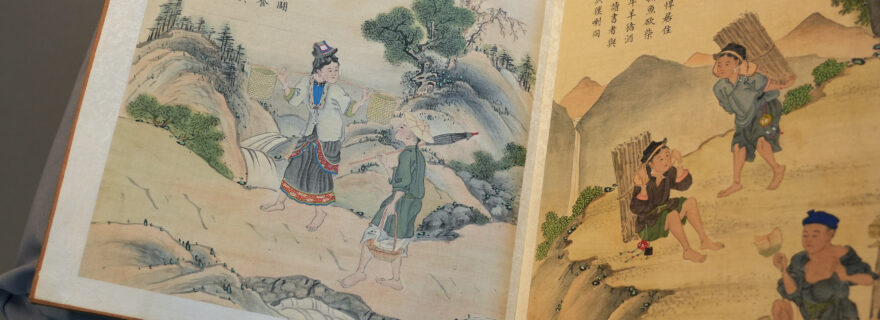Portraying Ethnic Groups in Yunnan: A Miao Album with Silk Watercolour Paintings
An exceptional two-volume Miao album, recently acquired by Leiden University Libraries, depicts non-Han ethnic groups living in Yunnan Province. The manner in which these groups are depicted tells us a lot about how officials viewed ethnic minorities in the Southwest of the Qing Empire.
This well-preserved album contains seventy full-page watercolour paintings on silk, depicting non-Han ethnic groups living in Yunnan, the southwest margins of the Qing (1368-1644) empire, and ten full-page watercolour painted maps of the region. Although generally categorized as Miao album, these seventy figure paintings do not exclusively comprise the Miao group, but also involves other ethnic minorities dwelling in the Yunnan region. According to the inscriptions on each painting, a total of around twenty ethnic groups are depicted, among which nine groups are painted more than once (e.g., twelve paintings of Baiyi [犭罷]彝, eleven of Woni 窩泥, and nine of Guoluo 猓玀). Possibly, the repetition of the same ethnic people and the exquisite drawings illuminate a more nuanced purpose of the album making, beyond establishing a unified encyclopaedic document for each group.
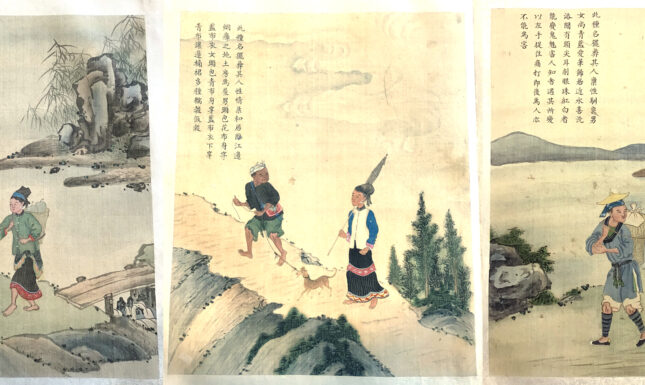

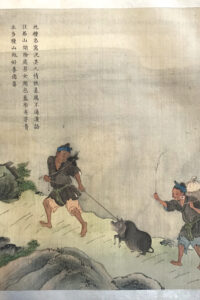

During the Qing dynasty, the imperial production of Miao albums reached a peak. These albums were produced for multiple purposes: some were used by the Qing Empire to supplement their empirical knowledge for frontier governance, and others were exported to the Western market. Considering the superb painting techniques, the unified format (37x30 cm), and the detailed local information conveyed by the inscriptions, it is very likely that the two albums were intended for a high-ranking official or the Qing court. They were also possibly drawn by court painters under the guidance of local officials serving in Lin’an district of Yunnan, who were familiar with the habitants and local customs in their ruling area. The inscriptions on the wooden box in which they are kept show that these two albums were once collected in Nagasaki, in 1880, by the British Bork merchant family.
Notably, the paintings as well as the accompanying inscriptions highlight the degree of perceived civilisation of each ethnic group. For instance, Boren僰人 is always, either visually or textually, depicted in the scenes of tilling and weaving (1-2; 1-29). The man wears the Qing hairstyle and official costumes, and is reading a book (2-2). By contrast, the Woni窩泥 group is depicted with bare feet, bad-tempered, and unable to understand the language of Han Chinese (1-36). These visual depictions correspond with the distinction of ‘uncivilized Miao’ 生苗 and ‘civilized Miao’ 熟苗 in the Qing dynasty and could aid the putative readers, most likely Qing officials, with their administration.
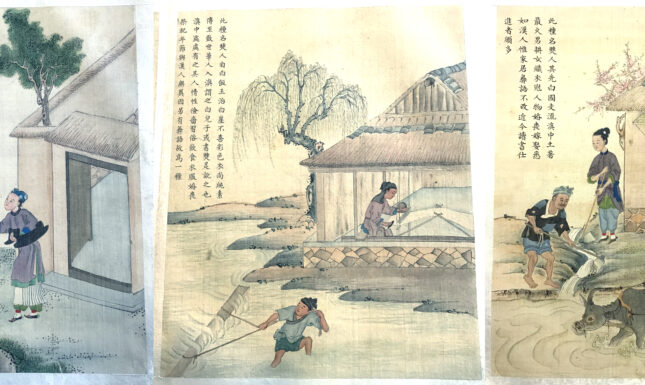



In addition to the identity of the ethnic groups, the albums also meticulously depict the background of the figures, i.e., the natural landscapes in which each ethnic people resided and the daily activities by which they earned their livelihoods. The depicted landscape, however, does not necessarily reflect the topographies in reality but was rendered in a paradigmatic and stylised way of landscape drawing by the Qing court painters. Comparing the different landscapes depicted in the albums, it is common to see the same ethnic group depicted as living in hugely different geo-spaces, or different ethnic groups as being accompanied by similar landscapes. For example, both Baiyi (1-7; 2-1) and Tuliao 土獠 (2-19) are located at a flat riverbank, with porous rocks and sprouted bamboo painted along the riverside, while another group of Baiyi (1-23) and Changmin 猖民 (1-13) are depicted as walking on a gentle hillside.
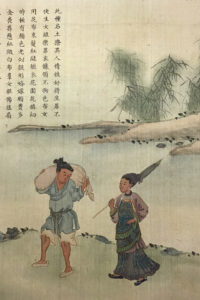

More broadly, the two-volume album in Leiden University Libraries can serve to have a dialogue with other albums of ethnic groups and illustrations of tributary people of Qing China. Some albums integrate scenic backgrounds with ethnic people, while others solely depict the main figures on each page. For instance, the album, Dianmiao tushuo 滇苗圖說, now collected by Harvard University Library as well as the book Diansheng yiren tushuo 滇省夷人圖說vividly depict the ethnic groups in Guizhou and Yunnan within a landscape background. Like these two sets, the Leiden University album also features scenes of carrying firewood, hunting foxes, catching fish, and shooting birds. These motifs, repeatedly appearing in various Miao albums, illustrate the collective memory of the Qing ruling class of the southwestern periphery of the empire and unveil the systematic production of local knowledge within an imperial context. Furthermore, the Qing dynasty’s production of various Miao albums is also closely interconnected with the making of the Illustration of Tributary People of the Grand Qing 皇清職貢圖, the product of a decade-long official project that not only identified more than thirty ethnic groups in Yunnan, but also included foreign people from the far-reaching Western world.
_____
Further Reading:
- Chuai, Zhenyu揣振宇, ed. Diansheng yiren tushuo滇省夷人圖說. Beijing: Zhongguo shehui kexue chubanshe, 2009.
- Ge, Zhaoguang 葛兆光. “Hua ‘sheng’ cheng ‘shu’?: Cong Qingdai ‘Miaoman tuxiang’ sikao minzu shi yanjiu zhong de wenti”化「生」成「熟」?——從清代「苗蠻圖像」思考民族史研究中的問題. Gujin lunheng古今論衡, 2019 (33): 4-33.
- Hostetler, Laura and Xuemei Wu, eds. Qing Imperial Illustrations of Tributary Peoples (Huang Qing zhigong tu): A Cultural Cartography of Empire. Leiden; Boston: Brill, 2022.
- Wang, Wanfa 王萬發. “Xingzhi yu guankan: Guanyu ‘Miaotu’ de shijue fenxi” 形製與觀看:關於“苗圖”的視覺分析. Minzu yishu 民族藝術, 2017 (6): 126-133.
Acknowledgements:
My sincere thanks go to Dr. Lin Fan for her inspiring comments and editing.
About the author:
Qinxin He is an education and research staff member and a PhD candidate at the Leiden University Institute for Area Studies.


